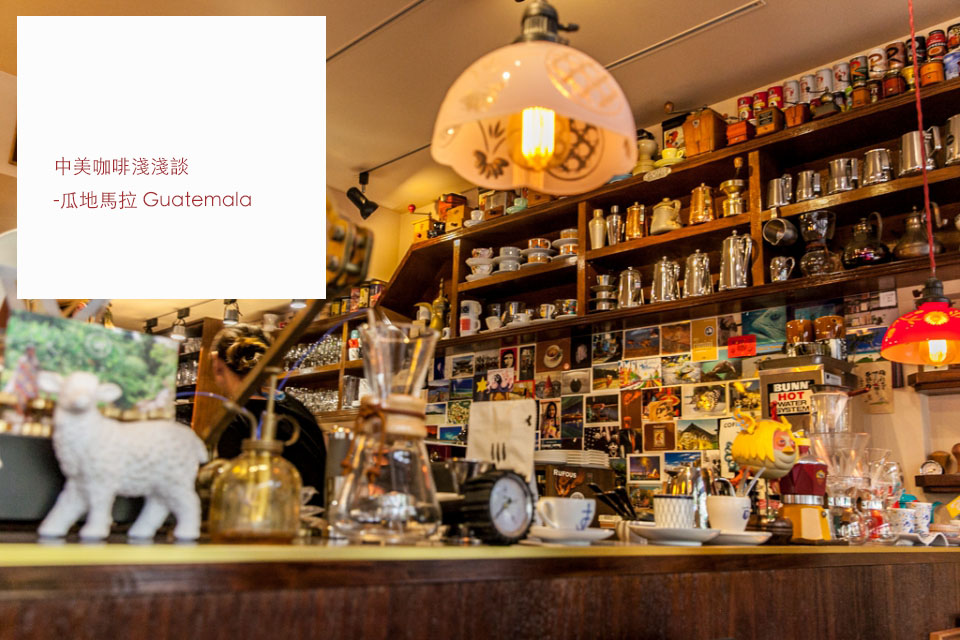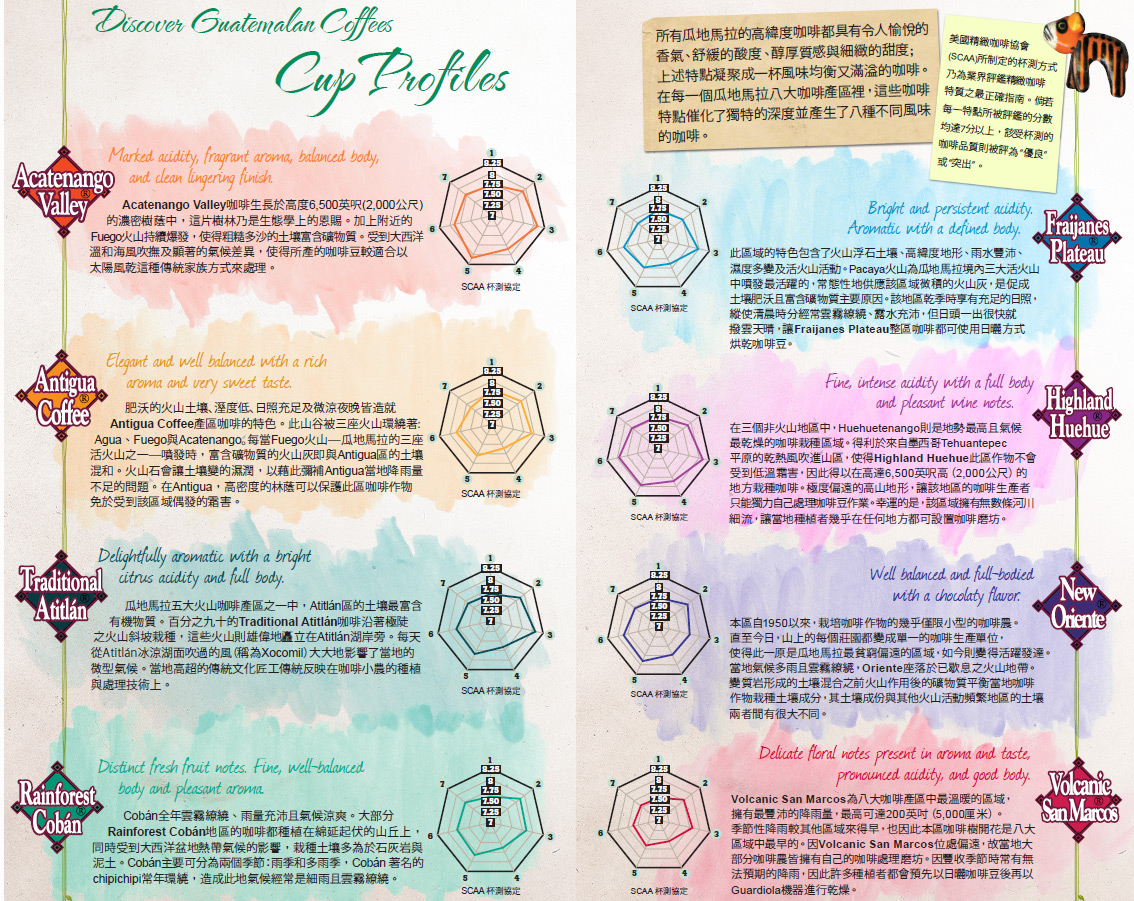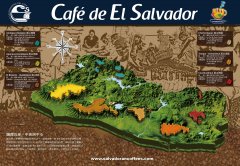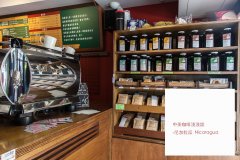A brief talk on Coffee from China and the United States-Coffee dancers, how to change is a boutique-Guatemala

For professional baristas, please follow the coffee workshop (Wechat official account cafe_style)
Guatemala is only three times the size of Taiwan.
However, it is rich in natural resources, which makes Guaguo coffee very amorous.
The common tonality is elegant and lively, clean and layered.
With green malic acid, jasmine, orange peel, green pepper, cocoa, some finish will have a strong smoky flavor.
Diverse and rich regional taste, ever-changing charming aroma
Surprisingly, almost half of them are boutique beans (45% belong to boutique grade).
What kind of style can make always high-quality coffee?
In addition to one's own qualifications, there is also a process of hard work.
Let's take a look at the 72 changes of Guatemalan coffee!

A brief history of coffee in Guatemala:
The earliest literature points out that Guatemala knew how to grow and drink coffee as early as 1747.
In 1845, with the establishment of the Coffee planting and Promotion Committee, coffee became an important cash crop in the region.
With the vigorous promotion of the government, coffee accounted for 90% of Guatemala's total export in 1880.
In order to achieve greater production, the authorities targeted the aboriginal land, forcing them to sell the land and move to more barren places.
The second exploitation came from large enterprises during the Great Depression of the global economy in 1930.
Jorge Ubico, the authority, strives to reduce costs in order to stimulate the export market.
At the same time, it also transfers more power and land to the United Fruit Enterprise Center (UFC) in the United States.
After Jorge Ubico stepped down, the incoming president, Arbenz, wanted to reclaim some land in UFC and redistribute it to farmers.
In 1954, the Arbenz government was overthrown by a coup launched by CIA of the CIA.
Poverty, uneven distribution of land, famine, discrimination against indigenous peoples and other factors led to civil war (1960 Murray 1966)
However, these problems still exist today.
Guatemala Coffee Mini File:
In terms of the main varieties of coffee, 98% is Arabica, but there are still 2% robusta varieties.
The treatment method is mainly washing and a small amount of it is in the sun. It is currently the 10th largest coffee producer in the world.
Guatemala altitude classification:
Like many Central American and Central countries, Guatemala has its own growth altitude classification:
Prime: plant 750 Murray 900 meters above sea level.
Extra Prime: planted at an altitude of 900 Murray 1050 meters.
Semi Hard Bean: plant 1050m above sea level. 1220m.
Hard Bean (HB): planted at 1220m above sea level in Murray 1300m.
Strictly Hard Bean (SHB): planted above 1300 meters above sea level.
Guatemalan coffee features:
Guatemala also has tropical rain forests, volcanic geology, plateau valleys and ever-changing microclimate.
Plus several rainfall patterns and fertile soil
It makes Guatemalan coffee varied in style and rich in tonality.
There are slender, elegant, sweet, fruity, but also more complex, rich, rich, with chocolate, toffee aromas.
Generally speaking, there are five major producing areas:
Vivette Nanguo (Huehuetenango): the highest altitude, less rainfall, late ripening, fruit and flower aroma, recognized as the best coffee producing area.
Antigua: dry climate, sweet coffee with nutty, spicy and cocoa flavors.
Coban: rain forest area, high rainfall and humidity, coffee taste is thick, with fruit and spicy aromas.
Atotlan: can be called the classic of Guatemala, with lemon, chocolate aromas, but also a thick taste.
Acatenango: hot climate and fertile volcanic soil, where coffee acidity and layers are relatively rich.
Trial drink of coffee from Guatemala:
Katamona Coffee
Catarmona imports alpine coffee directly from Central and South America.
It is the first coffee factory in Taiwan to be verified by FSSC 22000 (ISO 22000+PAS220) International Food Safety Management system (2011).
Guatemala Antigua (Antigua)
Coffee trees in Andigua District are planted at an altitude of 1300 meters above sea level and 1600 meters above sea level, with a dry climate.
The coffee has a uniform aroma, with nutty, spicy and chocolate flavors.
…… ……
Important Notice :
前街咖啡 FrontStreet Coffee has moved to new addredd:
FrontStreet Coffee Address: 315,Donghua East Road,GuangZhou
Tel:020 38364473
- Prev

A brief talk on ● Coffee Lin Zhiling, Sweet Cup favorite-El Salvador
For the exchange of professional baristas, please follow the coffee workshop (Wechat official account cafe_style) to collect coffee shops all over the world for many years, and coffee has changed from simple interest to some experience. This time, I have prepared a small topic to share with you: a brief talk on Chinese and American coffee, selected coffee beans from five countries in China and the United States, from producing characteristics and flavor to recommended cafes, I will take you to understand these producing areas in the simplest way.
- Next

A brief talk on Sino-American Coffee A mysterious guest who sings and sings softly and circuitously in ●-Nicaragua
For the exchange of professional baristas, please follow the coffee workshop (official Wechat account cafe_style). Someone said: were it not for the hurricane and turbulent political situation, Nicaraguan coffee would have achieved more than this, but there are also people who have been rehabilitated: it is altitude or local influence that has created a unique Nicaraguan flavor. Of course, this Nicaraguan flavor is not acceptable to everyone. What on earth is Niga?
Related
- Does Rose Summer choose Blue, Green or Red? Detailed explanation of Rose Summer Coffee plots and Classification in Panamanian Jade Manor
- What is the difference between the origin, producing area, processing plant, cooperative and manor of coffee beans?
- How fine does the espresso powder fit? how to grind the espresso?
- Sca coffee roasting degree color card coffee roasting degree 8 roasting color values what do you mean?
- The practice of lattes: how to make lattes at home
- Introduction to Indonesian Fine Coffee beans-- Java Coffee producing area of Indonesian Arabica Coffee
- How much will the flavor of light and medium roasted rose summer be expressed? What baking level is rose summer suitable for?
- Introduction to the characteristics of washing, sun-drying or wet-planing coffee commonly used in Mantenin, Indonesia
- Price characteristics of Arabica Coffee Bean Starbucks introduction to Manning Coffee Bean Taste producing area Variety Manor
- What is the authentic Yega flavor? What are the flavor characteristics of the really excellent Yejasuffi coffee beans?

